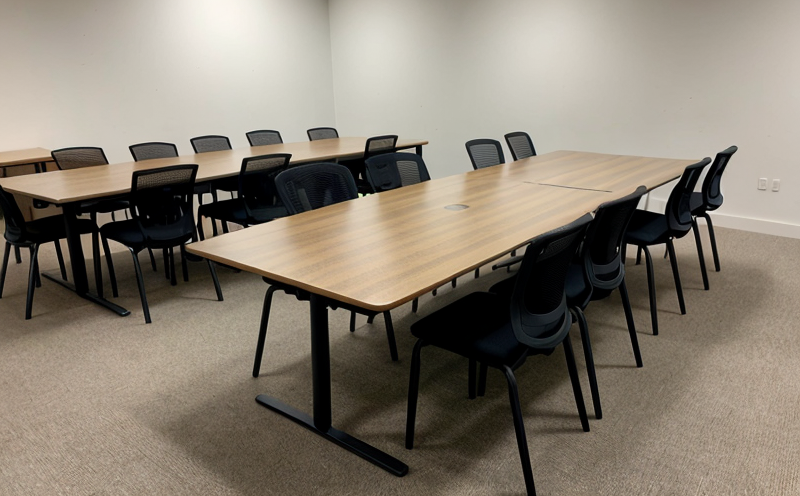ANSI BIFMA X7.1 Tables Indoor Air Quality Emission Testing
The ANSI/BIFMA X7.1-2013 standard establishes emission limits for volatile organic compounds (VOCs) from furniture products, including tables and desks. This testing is crucial to ensure that indoor environments remain safe and healthy, especially in offices, schools, and other commercial spaces where prolonged exposure to these compounds can be a risk.
Our laboratory offers comprehensive ANSI BIFMA X7.1 compliance testing for tables and desks, ensuring manufacturers meet the stringent emission limits set by this standard. The testing process involves placing specimens within a climate-controlled chamber designed to simulate real-world conditions. The chamber is monitored over time as it releases any volatile organic compounds into the air.
The test typically lasts 96 hours, during which continuous monitoring of VOC emissions occurs. Instruments like gas chromatography-mass spectrometry (GC-MS) are used to identify and quantify the specific compounds present in the emitted gases. The results provide a clear picture of the product's compliance with the ANSI BIFMA X7.1 standard.
Our team of experts ensures that all samples are prepared correctly, following industry best practices. This includes cleaning surfaces thoroughly, removing any packaging materials, and ensuring consistent exposure to environmental conditions throughout the test duration. Compliance officers and quality managers rely on our expertise to maintain product integrity and ensure market readiness.
The importance of this testing cannot be overstated in today's environmentally conscious world. By adhering to ANSI BIFMA X7.1 standards, manufacturers can demonstrate their commitment to providing healthy indoor environments. This is particularly relevant for products like tables and desks that are used daily by employees or students. The health benefits extend beyond the user; a safer product also enhances the reputation of the manufacturer.
Our testing service not only helps companies achieve compliance but also provides valuable insights into potential improvements in material selection or production processes. This proactive approach can lead to long-term cost savings and increased market share by appealing to environmentally conscious consumers.
- Stricter Limits on VOC Emissions: The ANSI BIFMA X7.1 standard is increasingly recognized for its stringent limits, making it a gold standard in the industry.
- Regulatory Compliance: Meeting these standards ensures that your products comply with international regulations and can be marketed globally without additional barriers.
- Promotes Healthier Workspaces: By reducing VOC emissions, our testing service contributes to healthier indoor environments, enhancing productivity and well-being.
In summary, ANSI BIFMA X7.1 compliance testing for tables and desks is essential for manufacturers aiming to produce high-quality furniture that meets the highest standards of safety and environmental responsibility. Our laboratory's expertise ensures that you can confidently meet these requirements, paving the way for successful market entry and sustained business growth.
Applied Standards
The ANSI/BIFMA X7.1-2013 standard is widely recognized for its rigorous approach to emission testing of furniture products. This standard sets forth specific requirements for the measurement, calculation, and reporting of volatile organic compounds (VOCs) emitted by furniture items during use in an indoor environment.
The testing process involves placing a sample table or desk within a climate-controlled chamber designed to mimic real-world conditions. The chamber is monitored continuously over 96 hours as it releases VOCs into the air for analysis. Instruments such as gas chromatography-mass spectrometry (GC-MS) are used to identify and quantify these compounds, providing precise data on emissions.
The standard requires that the total VOC emission rate does not exceed a specified limit. Compliance with this limit ensures that products meet the health and safety requirements set by regulatory bodies. By adhering to ANSI/BIFMA X7.1 standards, manufacturers can demonstrate their commitment to producing high-quality furniture that contributes positively to indoor air quality.
Our laboratory uses state-of-the-art equipment and follows strict procedures to ensure accurate and reliable results. This dedication to precision allows us to provide comprehensive testing services that meet the highest industry standards. Manufacturers who comply with ANSI BIFMA X7.1 not only enhance their products' marketability but also contribute to creating healthier workspaces.
International Acceptance and Recognition
The ANSI/BIFMA X7.1-2013 standard has gained significant recognition and acceptance in the furniture industry, both nationally and internationally. Its stringent requirements for measuring and reporting VOC emissions have made it a benchmark for ensuring indoor air quality in furniture products.
Many countries and regions, including North America, Europe, and Asia, have adopted or are considering adopting this standard due to its emphasis on health and safety. The United States, Canada, and several European Union member states recognize the ANSI/BIFMA X7.1-2013 as a critical tool for reducing exposure to harmful VOCs in indoor environments.
Manufacturers who comply with this standard can market their products globally without facing additional regulatory hurdles. This international acceptance enhances brand reputation and opens up new markets, contributing to sustainable business growth. By adhering to these stringent emission limits, companies demonstrate their commitment to producing high-quality furniture that contributes positively to indoor air quality.
Our laboratory's expertise in ANSI BIFMA X7.1 compliance testing ensures that manufacturers meet the highest standards of safety and environmental responsibility. This rigorous approach not only helps achieve regulatory compliance but also provides valuable insights into potential improvements in material selection or production processes. Proactive adherence to these standards can lead to long-term cost savings, increased market share, and enhanced customer satisfaction.





